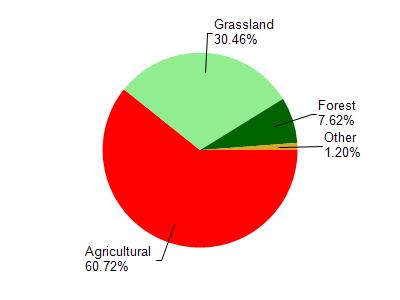Lafayette
No
No
No
Fish and Aquatic Life
Overview
This moderate sized warm water stream originates in Wisconsin and flows south into Illinois before curving back toward the north into Wisconsin and eventually entering the Pecatonica River. The Surface Water Resources of Lafayette County (1967) reports fair to good smallmouth bass and catfish populations. Much of the stream is impacted by bank erosion. A fish kill occurred in 1987. The stream has not been monitored recently.
Date 2002
Author Aquatic Biologist
Historical Description
Spafford Creek is a fairly large spring-fed and warm water drainage stream located in the southeastern corner of the county. Originating in Wisconsin it flows south into Illinois while curving north back into Wisconsin where it eventually flows into the West Branch of the Pecatonica River. Its tributary system includes Turtle Creek, Brown Branch and three unnamed feeders. Virtually all of the land within the watershed is used for agricultural purposes. Crops and open pasture cover over 95 percent of the watershed. Stream bank erosion is very heavy throughout its length since severe flooding is commonplace during the spring thaw and after periods of heavy precipitation. Most of the lowland areas adjacent to the stream are in firm pasture while the uplands are usually cropped. Woodlands are scarce throughout. Silt and gravel are the most common bottom types. The sport fishery consists of fair to good smallmouth bass and catfish populations. There is also a large population of forage fishes. Brown Branch, a tributary, is a managed brown trout stream. Game assets include pheasants and squirrels on the uplands and ducks, muskrats, raccoon and woodcock on the lowlands. Approximately four miles of stream are in the Spafford Creek Public Hunting and Fishing Grounds which are private lands leased by the Division of Conservation. Public access to the stream is possible within this area.
Spafford Creek, T1N, R5E, Sections 10-8, Surface acres = 10.8, Miles 7.5, Gradient = 5.3 feet per mile, Total alkalinity = 295 mg/l, Volume of flow = 10.7 cfs.
From: Piening, Ronald; Poff, Ronald; Threinen, C.W., 1967. Lake and Stream Classification Project. Surface Water Resources of Lafayette County, Wisconsin Department of Natural Resources, Madison, WI.
Date 1967
Author Aquatic Biologist
Condition
Wisconsin has over 84,000 miles of streams, 15,000 lakes and milllions of acres of wetlands. Assessing the condition of this vast amount of water is challenging. The state's water monitoring program uses a media-based, cross-program approach to analyze water condition. An updated monitoring strategy (2015-2020) is now available. Compliance with Clean Water Act fishable, swimmable standards are located in the Executive Summary of Water Condition in 2018. See also the 'monitoring and projects' tab.
Reports
Management Goals
Wisconsin's Water Quality Standards provide qualitative and quantitative goals for waters that are protective of Fishable, Swimmable conditions [Learn more]. Waters that do not meet water quality standards are considered impaired and restoration actions are planned and carried out until the water is once again fishable and swimmable
Management goals can include creation or implementation of a Total Maximum Daily Load analysis, a Nine Key Element Plan, or other restoration work, education and outreach and more. If specific recommendations exist for this water, they will be displayed below online.
Monitoring
Monitoring the condition of a river, stream, or lake includes gathering physical, chemical, biological, and habitat data. Comprehensive studies often gather all these parameters in great detail, while lighter assessment events will involve sampling physical, chemical and biological data such as macroinvertebrates. Aquatic macroinvertebrates and fish communities integrate watershed or catchment condition, providing great insight into overall ecosystem health. Chemical and habitat parameters tell researchers more about human induced problems including contaminated runoff, point source dischargers, or habitat issues that foster or limit the potential of aquatic communities to thrive in a given area. Wisconsin's Water Monitoring Strategy was recenty updated.
Grants and Management Projects
| Project Name (Click for Details) | Year Started |
|---|
|
|
Monitoring Projects
| WBIC | Official Waterbody Name | Station ID | Station Name | Earliest Fieldwork Date | Latest Fieldwork Date | View Station | View Data |
|---|
| 915600 | Spafford Creek | 10014193 | Spafford (atWayne Genter Rd) | 9/9/2014 | 9/9/2014 | Map | Data |
| 915600 | Spafford Creek | 333059 | Spafford Creek at Cth Dd | 10/12/2006 | 5/23/2022 | Map | Data |
| 915600 | Spafford Creek | 10031544 | Spafford Creek at Andrews Road | 10/12/2010 | 1/1/2015 | Map | Data |
| 915600 | Spafford Creek | 333056 | Spafford Creek at State Line Road | 5/1/1975 | 7/30/1975 | Map | Data |
| 915600 | Spafford Creek | 10014155 | Upper Spafford - (atCo Road Dd) | | | Map | Data |
| 915600 | Spafford Creek | 333058 | Spafford Creek - Bl Wood Andrews Ch | 5/1/1975 | 7/30/1975 | Map | Data |
|

Watershed Characteristics
Spafford Creek is located in the Lower Pecatonica River watershed which is 134.23 mi². Land use in the watershed is primarily agricultural (60.60%), grassland (30.40%) and a mix of forest (7.60%) and other uses (1.20%). This watershed has 333.90 stream miles, 40.87 lake acres and 274.90 wetland acres.
Nonpoint Source Characteristics
This watershed is ranked Not Ranked for runoff impacts on streams, Not Ranked for runoff impacts on lakes and High for runoff impacts on groundwater and therefore has an overall rank of High. This value can be used in ranking the watershed or individual waterbodies for grant funding under state and county programs.However, all waters are affected by diffuse pollutant sources regardless of initial water quality. Applications for specific runoff projects under state or county grant programs may be pursued. For more information, go to surface water program grants.